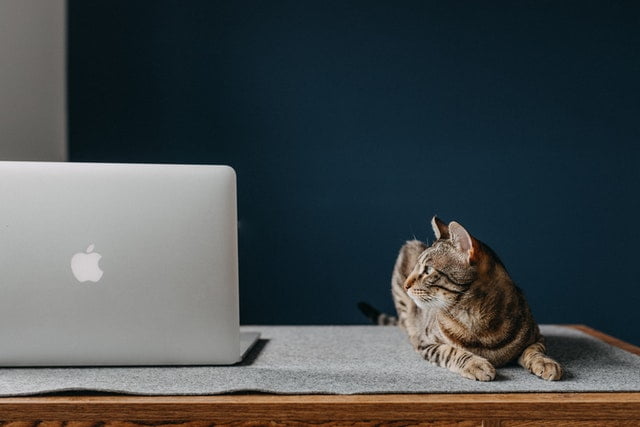
by Margejane | Cat Health, Featured
FIP was once considered fatal to cats. However, as the following article explains, there is a new treatment that has actually cured cats! This is wonderful news. Please read on, and thank you for your support.
In January 2021, Patty, one of my three Feral Fixers foster kittens, was diagnosed with wet/effusive FIP. It was devastating news since I had lost four out of five of one of my litters to FIP a few years prior and everything I’d ever read when researching it had said it was fatal. Patty’s belly was huge and I could feel every bone in her spine and hips. I had been syringe-feeding her at the time of the diagnosis since, once I noticed a big belly, I separated her from her sisters to monitor her food intake and noticed she wasn’t eating on her own. But once we got the official diagnosis, I was heartbroken. All I pictured was watching her deteriorate each day with an inevitable fate of death. I couldn’t bear it and Tammy didn’t want me to have to go through that either so we scheduled a euthanasia appointment for a couple of days later.
When I was holding Patty in my arms the night before her appointment, something was telling me that it wasn’t her time to go yet and I was drawn to my computer. I started Googling and researching and I can’t even remember what I was entering into the search bar but somehow I found out about a Facebook group called FIP Fighters. They were helping to clinically cure cats of FIP through a treatment called GS-441524. I answered the few questions required to join and waited to be accepted into the group.
The next morning, I had a message from one of the Administrators in my Facebook Messenger app. He told me about the three brands of treatment their group recommended, the dosages, the cost, and the frequent bloodwork required during treatment. I emailed Tammy and asked to cancel Patty’s euthanasia appointment and see if she’d approve of me trying this treatment if I bought the meds and Feral Fixers paid for the supplies, supplements, and monthly bloodwork. She said she was willing to give it a shot! Yes, we were putting our trust in this unknown drug from China, which was not approved for use by veterinarians in the U.S., but we really had nothing to lose.
I ordered the cheapest of the three medicines, gathered the required needles and syringes, and watched videos on how to give an injection. I also scoured through the FIP Fighters Facebook group, looking for posts with tips on how to give injections and helpful supplements to give during treatment, etc. I was terrified and dreading that first needle poke, knowing that I had so many more to go after that one.
The protocol for treatment is 84 days of injections, administered at the same time every day, with monthly bloodwork to see if improvements are being made, followed by 84 days of observation. If there is no relapse during the observation period, the cat is considered “clinically cured” of FIP.
I was about to venture into a six-month commitment to try to cure Patty but I was ready. I focused on the success stories shared by fellow FIP Fighters. I became obsessed with the Facebook group, tears constantly running down my cheeks as I read posts throughout the day. Sometimes tears of hope and joy when someone shared a success story and sometimes tears of sadness when someone shared their loss.
But the very special thing about this Facebook group was that everyone was so supportive and helpful. That, alone, inspired me since it is so hard to find these days. And it was an international group. I really felt like I had found “my people.” I was determined that Patty would be a success story and we could share her journey with others and let people know there IS hope after a FIP diagnosis.
After two weeks of injections, Patty’s distended belly had finally noticeably subsided and she was eating on her own. I syringe-fed her for quite a while, even supplemented her with it once she started eating little bits of food. Each day, I also gave her Pet-Tinic for her anemia, an injection of B12, and a milk thistle for liver support since GS-441524 is hard on the liver. (The Administrators of the Facebook group recommend liver support in conjunction with the treatment.) I shared each bloodwork report with my Admin to get his comments/suggestions.
Patty finished her 84 days of injections in April and was given clearance to enter the observation period. She finished her 84 days of observation in July without any incident of relapse and is now considered “clinically cured.” She took the injections like a champ and I am so proud of her. I’ve read many stories about cats who would really fight them so I felt very fortunate to have such a good
patient. And a positive side effect of this whole experience is that I felt proud of myself and became more confident in my capabilities to treat cats in the future.
Special thanks to Erika Vezza, author of this article, and Feral Fixers for permission to post this wonderful story. Visit FeralFixers.org to learn more about this great cat rescue organization.

by Margejane | Cat Health, Featured
Cats are particularly prone to kidney damage and it has a variety of causes. Infections, cancers, exposure to toxins, and malfunction of the immune system may all be responsible for starting a slow process of damage, leading eventually to loss of function and kidney failure. The original cause is often no longer present at the time of diagnosis and sometimes will never be discovered.
The body has more kidney tissue than it needs, so much may be lost before symptoms develop – and before blood tests show changes. This slow progressive process is referred to as “chronic” kidney disease. Occasionally, previously healthy kidneys suffer sudden and massive damage (acute kidney disease) but this is less common.
What do the kidneys do?
Kidneys filter the blood and take out poisonous by-products produced by the workings of the body. These are added to water to form urine.
They also get rid of excess water into urine or, when water is lacking, can concentrate urine to reduce water loss. When they are diseased, the ability to concentrate urine is lost and the animal has to drink more to get rid of the body’s waste products.
The kidney regulates the number of various salts (sodium and potassium, among others) within the body by moving smaller or larger amounts into the urine. Kidney disease may cause some of these to build up within the circulation making the animal ill and perpetuating the kidney damage.
Other functions of the kidney include the production of chemicals called hormones. One hormone causes the blood vessels to expand or contract – lowering or increasing the blood pressure. Another hormone stimulates the body to make red blood cells so, when the kidney’s hormone production is out of balance, this can sometimes cause anemia.
How is kidney disease diagnosed?
Diagnosis is reached by a combination of blood and urine tests. An increase in the toxic substances that the kidney normally removes can be measured in the bloodstream. Looking at the concentration of the urine is also helpful.
In kidney disease, urine is diluted and more prone to infection – which can be detected by tests. In some cases, the only way of finding the cause of the disease is by biopsy (removing a piece of kidney for examination).
This involves an operation, therefore, it is often not done unless there is a chance that a definitive diagnosis could help in the treatment of your cat. In many cases, the damage – which causes the symptoms – cannot be reversed.
What are the symptoms?
Everyone knows that in an animal, drinking lots of water can be a sign of kidney disease, but this can also be a symptom of other illnesses.
Cats are discreet and maybe secret drinkers, so early signs of excess thirst may be missed and they may become quite ill before treatment is sought.
As kidney disease advances, other symptoms include weight loss, signs of dehydration, poor appetite, smelly breath, a sore mouth, vomiting and weakness. Eventually, there may be twitchiness or even fits. However, these symptoms are common to many illnesses, not just kidney disease.
What is the treatment?
There is no cure. Treatment aims to minimize the symptoms, by reducing toxin production, keeping salt levels normal, and slowing the rate of ongoing damage.
Cats that are unwell and severely dehydrated may benefit from intravenous fluids to re-hydrate and flush out toxins. If improvement does not follow, then kidney damage may be severe, and you should consider the options carefully with your vet. Home nursing is very important.
The toxins produce nausea, loss of appetite, and sometimes mouth and stomach ulcers. Tempting food, such as fresh fish or chicken, warmed and given by hand may help. If loss of appetite is long-term, your cat’s quality of life becomes questionable and should be discussed with your vet.
How long will my cat live?
This varies, depending on the severity of the disease, the underlying cause, and the speed at which ongoing kidney damage is occurring – something which only time will reveal.
The most important consideration is the well-being and happiness of the patient. Some cats, although thin and drinking lots, stay reasonably well for one to two years or more. Others can be unwell and deteriorate rapidly within weeks.
Long-term treatment
Free access to water is essential, especially in the summer. If the cat is accidentally shut in without water, dehydration and toxin build-up can happen rapidly.
Encourage your cat to drink by placing water bowls in several rooms. Cats prefer dog size bowls, which should be filled to the brim and placed away from feeding places.
Some cats prefer running water so consider getting a water fountain. Many of the toxins come from dietary protein, and there is increasing evidence that low protein diets improve general condition and longevity. Cats can be very reluctant to try new foods, so try to start dietary change at initial diagnosis, when the cat’s appetite may be better. Be prepared to mix new and old diets together for one to two weeks.
Warming food may help. However, with a cat that absolutely refuses to eat the diet, maintaining a healthy appetite becomes more important than eating a special diet.
You need to discuss what is best for your animal with your vet. Anabolic steroids may be given in an attempt to improve appetite and reduce weight loss.
Other drugs, which are sometimes used, include ACE inhibitors. They may preserve function in undamaged parts of the kidney, while anti-nausea drugs, appetite stimulants, and anti-ulcer drugs may improve appetite.
Excessive potassium loss due to failing kidneys may lead to weakness, therefore potassium powder or tablets may be prescribed.
Phosphates may build up in the circulation of patients with kidney problems, worsening the kidney damage, so your vet may prescribe medicine to reduce your cat’s intake of phosphates, especially if your cat is not eating a special low protein diet.
A blood pressure check may be suggested. High blood pressure worsens kidney damage and unfortunately, kidney disease can cause high blood pressure – working in a vicious circle. In advanced cases of anemia, there are treatments to stimulate red blood cell production, but these are expensive, only work short-term, and are not suitable in all cases.
Your vet will discuss with you what is best for your cat. In summary, kidney disease cannot be cured, but there are treatments that may make your pet feel better.

by Margejane | Featured
In case you don’t know, every year 3 events are held dedicated to these wonderful animals that make our lives happy every day.
Do you want to know why there are 3 annual dates dedicated to felines?
I would tell you that they deserve this and more and that for me, every day is International Cat Day. And I go even further, I would like all this popularity to be translated into spreading messages of adoption and responsible ownership of these extraordinary beings with whom we have the privilege of sharing the planet.
The love for cats is celebrated every February 20, but it also has a place on August 8 and October 29. Next, I will tell you what these dates are due to.
Why is International Cat Day commemorated on February 20?
This feline date takes place every year, on February 20, and its origin is quite peculiar and is linked to one of the most popular American presidents.
The reason for celebrating International Cat Day is due to Socks, the furry companion of the Clinton family (yes, those people who lived in Casablanca between 1993 and 2001 during the US presidency)

Socks was adopted by the president’s daughter in 1991 and over time gained the attention and affection of Americans. And it was not surprising, he was gorgeous, had a black and white fur print, and seeing him on the lectern in the press room was quite a sensation.
This cat was an important member of the family and the media photographs of the cat with Bill on his shoulder, playing in the garden, running around offices, and even appearing in Christmas images in front of the tree were very common.
A few years later, Socks was diagnosed with cancer and after some time trying various treatments without success, they made the decision to end his suffering on February 20, 2009.
After his death, users on social networks echoed the sad news and declared February 20 as International Cat Day to remember Socks.
International Cat Day: celebration August 8
The second date dedicated to these incredible animals is August 8. It is also considered International Cat Day, but in this case, its origin is due to the International Fund for Animal Welfare (IFAW: International Fund for Animal Welfare), the organization that decided to dedicate a day specifically to them in 2002.

Do you know why it is precisely on this date?
Do you know why it is precisely on this date? The reason is that in the northern hemisphere it is the time of year when felines are most likely to be in heat.
The reason for this commemoration is to remember that although cats are incredible companions for life, it is vital that we be responsible and aware of the care and attention they require.
This day is the perfect excuse to get to know the felines even better and therefore the IFAW usually makes recommendations in this regard to shedding light on the nature of these animals.
International Cat Day: celebration October 29
And since there are not two without three, here is the third date dedicated to the kittens. The celebration of this International Cat Day on October 29, is due to a woman named Colleen Paige, an expert in feline behavior.
Colleen’s goal was to make people aware of the terrible situation cats live in, especially those who live in the streets.
This day serves as a pretext to speak out loud about the consequences of abandonment and its goal is to promote adoption.
And if you’ve made it this far, I leave you five posts for you to take loving care of your furry companion:
Can you give me a leg and spread it on Facebook, Twitter, and Instagram?
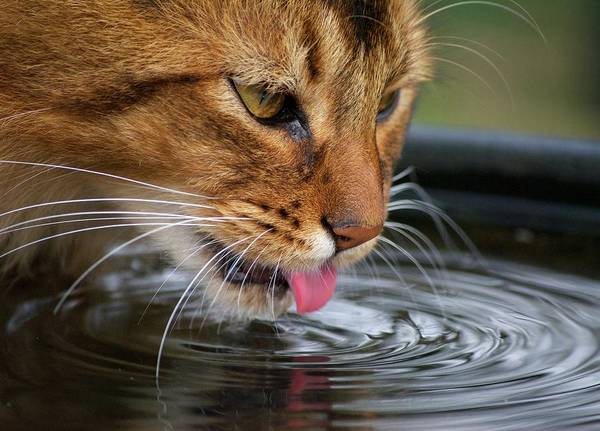
by Margejane | Cat Accessories, Featured
A cat water fountain is a motorized pump that circulates water via a series of filters (or a single filter). It pushes the water up into a fountain stream or bubbler. This system of water movement helps to keep it clean, cool, and aerated – providing water that tastes fresher and better to your feline buddy.
Why should you get a cat fountain?
Your cat needs to drink more water every day, especially if they are on a dry food diet. A cat fountain is one great way to ensure your cat stays hydrated all day long. Cats, as it has been discovered, are naturally attracted to trickling or running water. Hence, a water fountain is a good investment to encourage a good drinking habit for your cat.
Adequate hydration will consequently improve nutrient absorption, enhance better digestion, and assist to flush out bacteria and toxins that can accumulate in your cat’s digestive and urinary tract. Has your cat ever suffered a urinary tract infection in the past? Then you should get her a cat fountain to avoid future infections.
Bonus pro: Are you tired of your cat going to drink from the toilet or sink all time? A cat water fountain is also an effective solution to encourage your cat to hydrate from their water bowl instead of the toilet bowl.
How often should you change the water in your cat’s fountain?
Your cat fountain should be cleaned every 3 – 4 days for several cats and about 5 – 6 days for just one cat. You should consider the number of cats you have, as well as if they have short or long hair. Keep in mind that long-haired cats will typically want more frequent cleaning.
Top 5 cat fountains
Do you have a picky drinker? Well, not anymore! The Catit Flower Pet Fountain is a colorful and inviting water bowl that is sure to be your cat’s favorite. It is an innovative fountain that features a unique and customizable design, encouraging your buddy to drink more water to keep her hydrated and healthy.
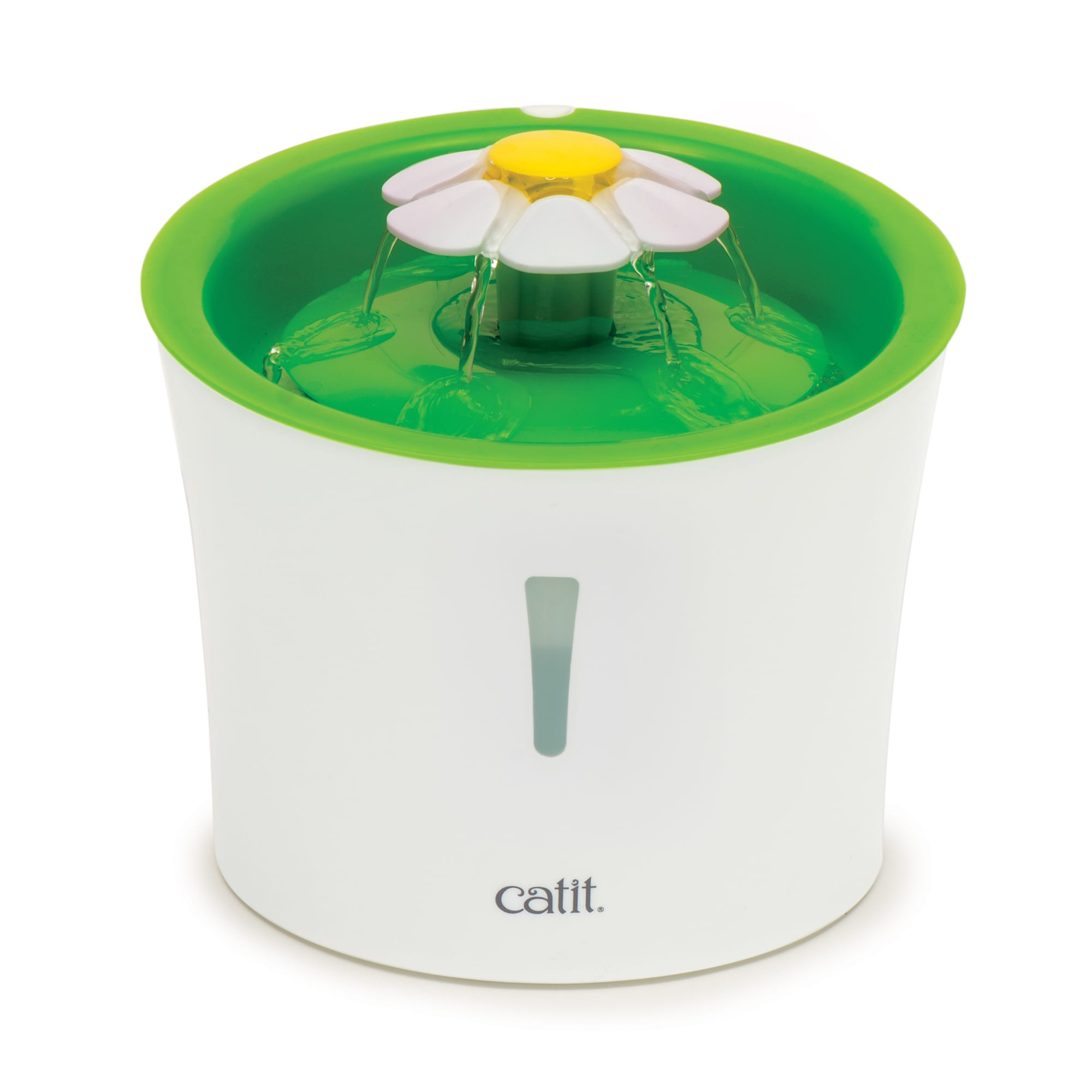
It comes with 3 water flow settings, so you can switch between a faucet-like stream, a bubbling top, or a calm flow of water. So enticing your fussy pet to have a drink has never been easier. While your cat enjoys a continuous flow of cool water, there’s a triple-action filter that removes dirt, odors, calcium, and magnesium. Unlike other cat water fountains, this beauty does not give room for debris to settle in and build up. Instead, your cat is always drinking from a clean, hygienic container. We call this flower magic!
Get Catit Flower Waterer at the best price here
The Frisco Gravity Refill Pet Waterer is no ordinary water bowl! It’s a unique self-replenishing oasis that provides seemingly endless hydration for your pet. One amazing thing about the gravity waterer is how it automatically refills the reservoir after your pet drinks, making you rest assured that they won’t be left thirsty when you’re out working (or partying, lol). It features a water bottle on top that has a very large opening for easy refilling and cleaning, and a base with easy-to-lift fitted handles, allowing you to move the water fountain to wherever you want in your home.
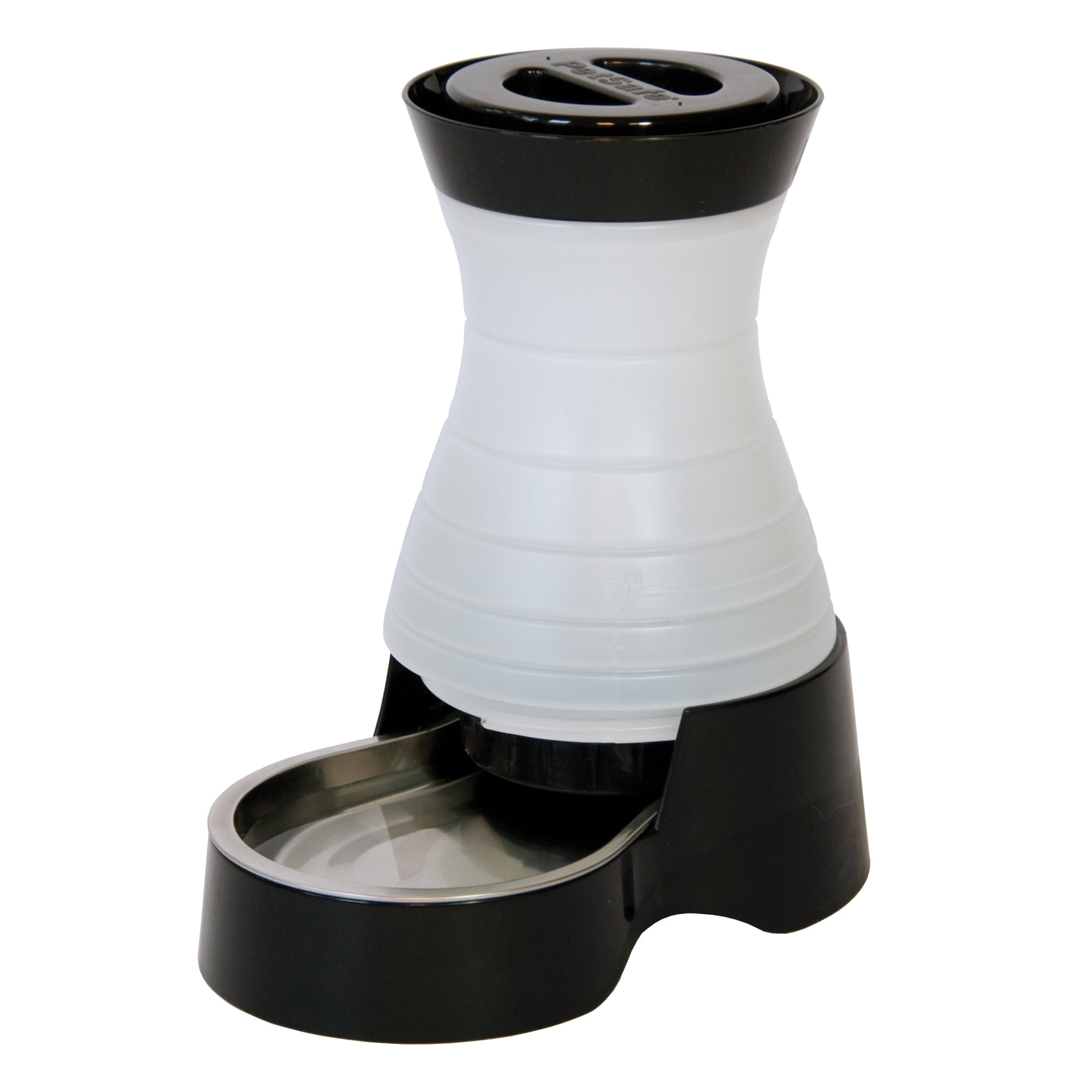
The Frisco Gravity water fountain is a perfect product for daily use for cats of all ages, and even other pets as well – from gerbils and hamsters, rabbits, and ferrets to dogs. It comes in a variety of different sizes so you get to pick whichever one best suits your cat’s needs.
Get Frisco Gravity Refill Pet Waterer at the best price here
This product has been designed to increase your pet’s desire to drink more water by exemplifying a natural water source, rather than some boring, stagnant water bowl. It has the capacity to hold a gallon of water, which makes it suitable for owners of multiple pets. In addition, the stainless steel construction offers great resistance to bacteria and makes maintenance simple. In fact, it can be thrown into a dishwasher (excluding the pump)!
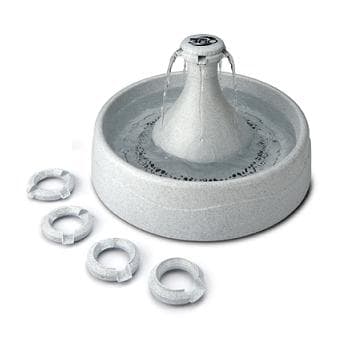
It also has rubber feet that prevent sliding and adjustable flow control to minimize splashing. In all, this product is a good choice for both small pets and large, giant breeds.
You can get this amazing product here

The PetSafe Sedona Pet Water Fountain is an elegant water-container upgrade that is perfect for households with many pets. It features a large drinking dish that allows multiple pets to drink at the same time, and it accommodates pets of all sizes. It utilizes a super-quiet pump, so your skittish cats won’t be afraid to approach the water fountain. The PetSafe Sedona Pet Fountain has been manufactured with a sleek design, featuring a ceramic tower and force-resistant transparent plastic dish that reduces spills and splashes. More importantly, it features a replaceable foam filter that captures debris and hair, and an activated carbon filter that removes odors and bad tastes. It is also dishwasher safe (only the top rack).
You can buy this stylish product at the best price here
5. Cat Mate Shell Plastic Pet Fountain
With the capacity to hold as much as 100 ounces of water, the Shell Plastic Pet Fountain by Cat Mate is sure to provide your furry pet with an enjoyable flow of clean water. It features multi-height water drinking platforms with a shell attachment which forms a stream of naturally oxygenated, cold water to entice your “paw-toner”. This innovative water fountain offers 3 stages of filtration, thereby preventing unhealthy debris deposits. It also has minimum and maximum water level indicators so that your cat never goes to an empty fountain with an alarming sound that goes off when the water level is down. You can get this product with free shipping when you use the button below.
Get the best pricing here.
Summary
So there you have them: the 5 top cat fountains for your sunshine. Getting a cat water fountain is a prerequisite for maintaining a long and healthy life for your best bud. To get any of the above amazing products at the best price, use the button below.
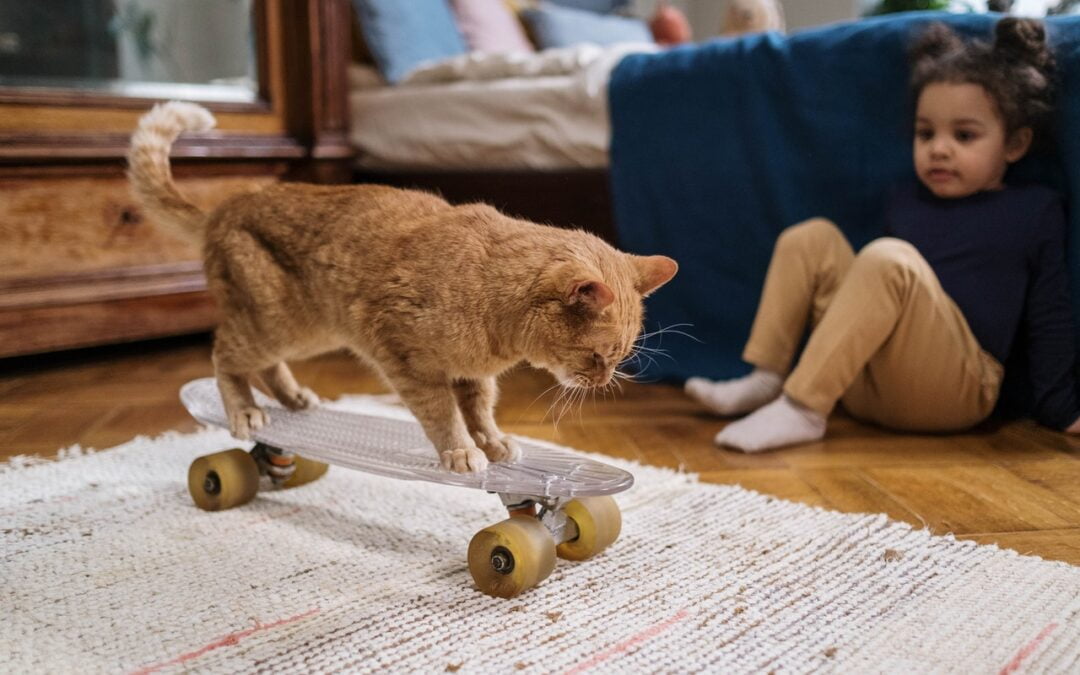
by Margejane | Cat Behaviors, Featured
Cats have a long history of improving people’s moods and brightening their days, which also appears to be true for children with autism, new research published in the Journal of Pediatric Nursing has revealed.
The small study suggests that adopting a shelter cat may help reduce separation anxiety and improve empathy in children with an autism spectrum disorder (ASD).
“Cats and pets in general, offer unconditional acceptance and someone to talk to and to be heard with. And caring for an animal can help them learn to be responsible, “said Gretchen Carlisle, study author and scientific researcher at the Research Center for Human-Animal Interaction at the University of Missouri in Columbia, United States.
ASD is a brain disorder that affects social skills, communication, and impulse control. In the United States alone, it affects one in 54 children, according to the Centers for Disease Control and Prevention (CDC) in that country.
The new work included 11 families who had children with autism between the ages of 6 and 14. The families were followed for 18 weeks after adopting a shelter cat. The researchers used standardized social skills and anxiety scales to choose the children who were likely to respond well to a pet. The cats were also evaluated for temperament.
In general, parents reported an instant bond between child and cat, and the bond remained strong over time, even with the added responsibility of caring for the pet.
The researchers found that the children’s separation anxiety, bullying, and hyperactivity decreased over the study period and they showed more empathy after adopting the cat. Most of the families kept the animal after the study ended.
Carlisle stressed that it’s not that cats are a better choice than dogs, but feline companions may be particularly suitable for some children with autism and their families.
“Many children with autism have sensory issues and when a dog barks in your face it can be really overwhelming, whereas cats just sit next to you and are less overwhelming from a sensory point of view,” he explained.
Cats can also be much easier to care for, especially for parents of children with autism who already carry a heavy load of responsibilities and stress, Carlisle said.
However, he added that the right combination is key.
“We specifically selected cats from 10 months to 4 years because there is previous documentation that younger cats are more sociable with children with autism, and adult temperament tends to establish at 10 months in these animals, so as young as 10 months old, cats already have the adult temperament,” Carlisle explained.
Several autism experts agree that adopting a pet can have benefits for children with autism and their families, always taking into account the information mentioned above. If you have a daughter or son with autism and you have more questions, consult a specialist in the field.

by Margejane | Cat Food & Treats, Featured
What Is a Raw Diet for Cats?
A raw diet for cats involves feeding them uncooked animal products. This includes muscle meat, organ meat, and bones. This type of food is sometimes called the BARF diet, which stands for “bones and raw food” or “biologically-appropriate raw food.”
The ideal raw diet for cats is prepared based on a carefully designed recipe. Many cat owners choose to prepare these diets themselves at home, but commercial forms are also available. If you choose to feed your cat a raw diet, it should be one that has been determined complete and balanced by a veterinary nutritionist. Cats that eat an imbalanced diet are at risk for a variety of health issues.

Why Consider It?
Felines are obligate carnivores.2 In short, this means they must eat animal products to survive. Cats don’t actually need vegetables and carbohydrates in their diets. In fact, they can only tolerate carbohydrates in small amounts. Instead, cats thrive on high-protein, high-moisture diets that are rich in substances only found in meat. This includes amino acids such as taurine, fatty acids, and other essential vitamins and minerals.
Supporters of raw food diets believe that cooking meat can alter or decrease these vital substances. They advocate for a biologically-appropriate diet that closely mimics what a cat would eat in the wild. In general, small wild cats hunt and eat rodents and other small mammals, birds, fish, insects, and even reptiles. When it comes to feeding your own cat raw food, the idea is to create a diet that is similar.
There is much controversy revolving around raw food diets for pets. Those who support raw food diets have much to say about the health benefits: coats are shinier, teeth stay cleaner, obesity is prevented, and overall health is better. While these claims tend to ring true, the opposition has valid concerns about the safety of raw food diets.
Are Raw Food Diets Safe?
It is important to know that feeding raw food to your cat does come with some risks. Raw food may contain pathogens like Salmonella and E. coli that can lead to serious life-threatening infections. Cooking food removes most of these pathogens, which is why we humans tend to cook our food.
Cats often digest raw foods better than humans because they have shorter, more acidic digestive tracts. Many pathogens will pass through a cat without causing any issues. Most cats will tolerate raw food, but those with health concerns (such as immune-mediated disease) may need cooked food.
Perhaps the greatest risk of feeding and handling raw meat comes down to cross-contamination. Feeding your cat a raw food diet can expose you and other people in your home to dangerous pathogens. Pathogens may remain on preparation surfaces, food dishes, in cat fecal matter and even on your cat (especially around the face).
Raw diets should not be fed to cats living in homes with immune-compromised individuals. They should also be avoided in households with young children and/or elderly people.
While it’s impossible to eliminate all risk, there are some ways to try to be safer when feeding a raw food diet to your cat:
- Prepare the food in a contained area of the home; clean and sanitize thoroughly when don. (use a 1:32 bleach to water solution if possible)
- Wear gloves when handling raw meat
- Handle food frozen when possible
- Use meat ingredients from a reliable source
- Feed your cat in an area that is easy to clean (no carpeting or upholstery nearby)
- Sanitize food bowls immediately after feeding (scrub clean, then use a 1:32 bleach to water solution, then rinse and dry bowls)
Bones are another safety concern when it comes to raw food diets. Some small whole bones or pieces of bones can cause complications such as gastrointestinal obstructions, oral injuries, and airway obstructions. If animal bones are included in your cat’s raw food diet, they should be ground up well.
Complete and Balanced Raw Food Diets
One of the biggest mistakes owners make with raw food diets is not making sure the diet is complete and balanced. Some people just feed “all meat and bones” or a wide variety of meats without actually paying attention to the calorie, fat, protein, and nutrient content. Do not assume your cat is getting everything needed for good health by simply feeding “as much meat as desired.” Over time, an incomplete diet can lead to serious health problems for your cat.
You may think that random raw meat is healthy because feral cats and strays can subsist on this, but it’s important to remember that wild animals have shorter life expectancies than domesticated pets. Part of this is due to diet. That’s why it’s important to follow a vet-approved recipe that is complete and balanced.
When developing your cat’s raw diet, consult with your veterinarian about recipes that offer complete and balanced nutrition for your cat. Know that many vets will not recommend raw diets due to the risks involved. If you feel strongly about trying a raw diet and your vet is not flexible at all about raw diets, seek out a veterinarian who is experienced with raw diets. Better yet, find a veterinary nutritionist with raw diet experience.
Raw Diet Alternatives
If you would like to eliminate the risks associated with raw food, but still feed your cat an optimum diet, consider home-cooked cat food. You will still need to find a recipe that is complete and balanced.
Or, choose a high-protein wet cat food made with high-quality ingredients. Most vets and experts now agree that dry kibble has too many carbohydrates to be considered optimum for cats. Fortunately, many wet foods are prepared with few carbohydrates or even none at all. Reducing or eliminating carbohydrates in your cat’s diet may increase longevity. A low-carb diet can also prevent health issues like obesity and diabetes mellitus in cats.














Recent Comments